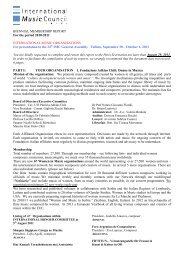Appendix 6 - International Music Council
Appendix 6 - International Music Council
Appendix 6 - International Music Council
Create successful ePaper yourself
Turn your PDF publications into a flip-book with our unique Google optimized e-Paper software.
peace building. The tour includes, amongst others, Indonesia, Sierra Leone, Honduras, and<br />
Guinea.<br />
http://www.iearnsierraleone.org/pages/partner/partnerships.html<br />
LIVE 8, G8 NATIONS AND SOUTH AFRICA<br />
Live 8 took place in July 2005, it was a series of benefit concerts, re-using the concept of<br />
"Live Aid" in 1985. The concerts took place in the G8 nations and South Africa. The shows<br />
aimed to put pressure on world leaders and politicians to drop the debts of the world's<br />
poorest nations, negotiate fairer trade rules in the interest of poorer countries, and increase<br />
and improve aid. They were running parallel with the Make Poverty<br />
History campaign in<br />
the UK and timed to precede the G8 Conference and Summit held at the Gleneagles Hotel<br />
in Perthshire, Scotland from July 6-8, 2005. More than 1,000 musicians performed at the<br />
concerts, which were broadcast on 182 television networks and 2,000 radio networks.<br />
There were ten simultaneous concerts held on 2 July and one on 6 July.<br />
http://www.live8live.com/<br />
3 The links between musical diversity and the<br />
promotion of peace<br />
GENERAL<br />
As the following examples from contemporary Europe show, music can, of course, be<br />
associated with both: peace and war, social harmony and social disharmony.<br />
For example,<br />
the Ukrainian Orange Revolution was associated with music, but the opposite side, the<br />
party of Janukovich, employed music as well. <strong>Music</strong>al diversity (in all our definitions) in<br />
contrast to music in general, however, tends to be associated with the promotion of peace<br />
and social harmony everywhere in Europe. Apart from the projects mentioned below there<br />
are many similar projects which we do not present here. Our focus lies on projects, because<br />
here, the association<br />
with peace and war, harmony and disharmony is particularly evident.<br />
This link between the two spheres becomes most obvious in projects<br />
aiming at the<br />
integration of people which have been or still are in a conflict situation, such as in former<br />
Yugoslavia or in the case of Israel/Palestine. Many<br />
projects of this kind are brought into life<br />
not by the government, but by NGOs, associations and other private organizations.<br />
There is a transitory zone between projects aiming to reduce social disharmony and projects<br />
seeking to fight poverty. Therefore, there might be some overlappings with section 2. As<br />
well, there is a certain correlation of this section with section 5, which deals with the<br />
promotion of non-pluralistic musical identities.<br />
Albania<br />
In 1997 with the collapse of the pyramid scheme many Albanians lost their savings,<br />
economy collapsed and riots broke out. Some 2000 people died. The situation<br />
was out of<br />
control and close to a civil war. An interviewee recalled a scene where music served as a<br />
symbol for peace and marked<br />
the beginning of normality after the riots had ended. In Vlorë,<br />
a city in the south of Albania, and at that time practically a ghost town, normal people of<br />
different backgrounds (policemen, a shepherd etc.)<br />
joined to perform a concert. The fact,<br />
that a concert was held, symbolized<br />
the end of the riots for the population of Vlorë. It was a<br />
325



